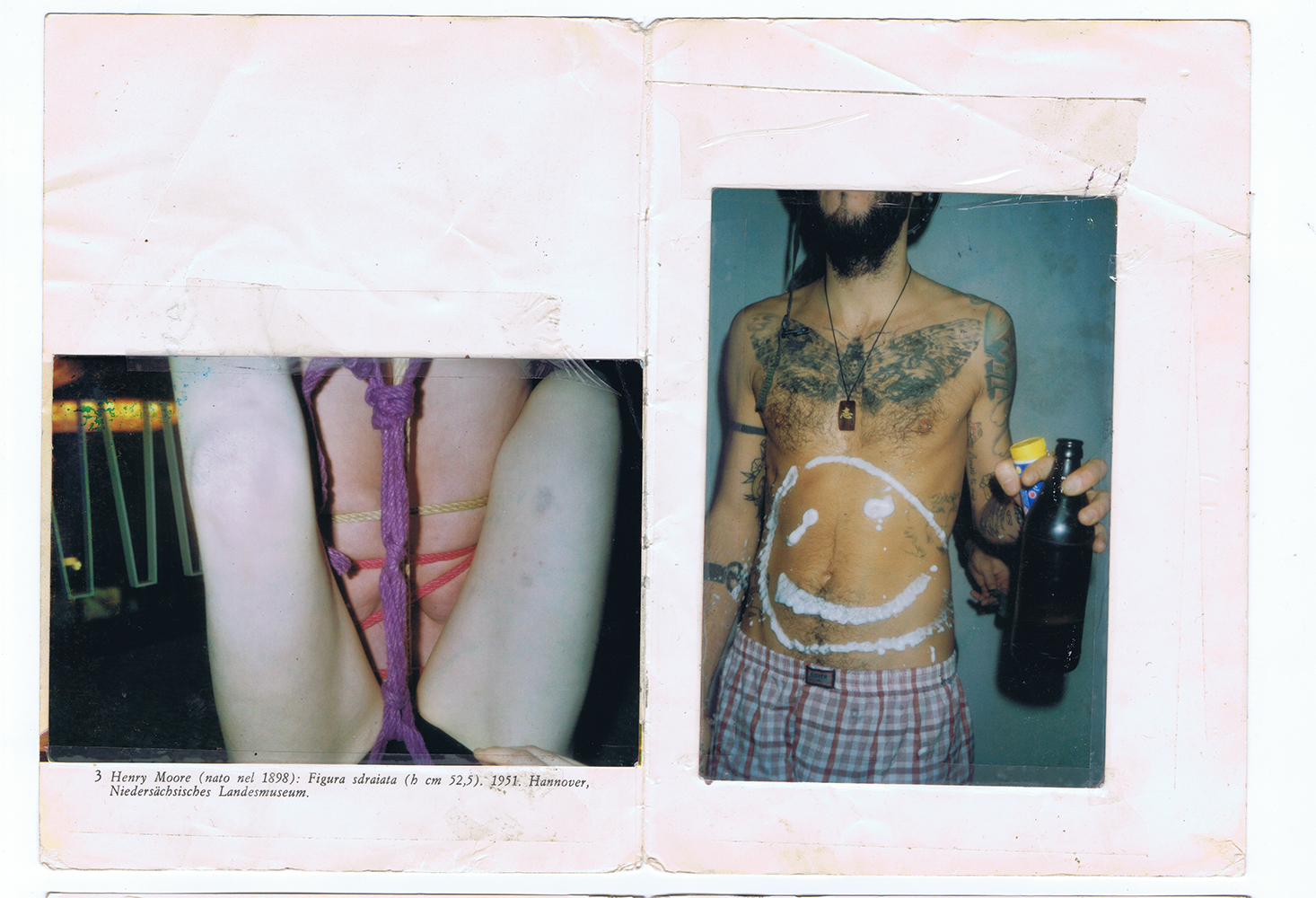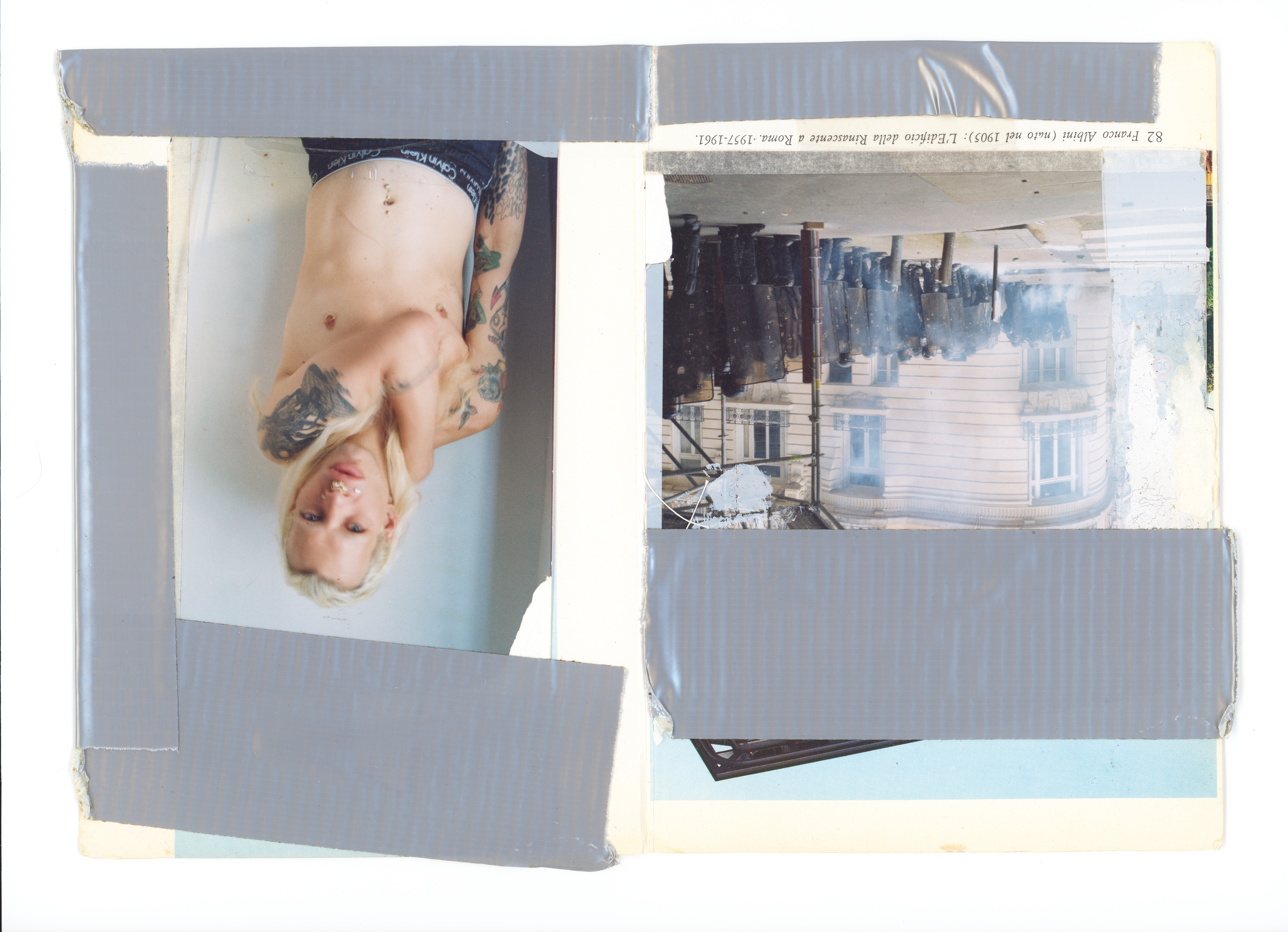Universal History of Art 37 tells the story of a young boy’s journey of redemption and transformation, who, lost in the Berlin freedom of bygone times, finds himself enslaved by his own self and the reality he has created until he ultimately discovers completeness in art. It all begins when, returning from one of his many disastrous nights, Ludovico stumbles upon a small analog compact camera in the streets of Neukölln. From there, the still-unaware artist decides to use photography as an escape from a static reality full of contradictions.
Universal History of Art 37 is a project that flows and arises from a collaboration between the artist and the inevitability of life itself, resulting in a diary composed of photographs and archival material, using an art encyclopedia titled STORIA UNIVERSALE DELL’ARTE 37 as a support. This book was stolen by the artist’s schizophrenic uncle from Porta Portese, who later gifted it to him as a sign of respect and admiration. Ludovico accepts this gift as an omen and decides to pour all his experiences into the book, declaring that everything placed inside would become his “UNIVERSAL HISTORY OF STORY,” or a personal artistic manifesto made of life, luck, and misfortune transformed into fortune.
This manifesto, which later influences all of Ludovico’s
creative approach, lays its foundations in Berlin’s punk, libertine, and brutalist culture, London’s DIY ethos, and Roman neorealist narrative, resulting in an artistic hybrid dedicated to escapism that is as reckless as it is beneficial






























The diary is divided into five volumes, inspired by the structure of essays in dramaturgy and cinematic screenwriting, which often divide the narrative into
3, 5, or 7 acts. Following this schema, as in a film or theater performance, Ludovico divides his experience into five narrative arcs. In the first volume, he presents and introduces his starting situation: a web of anger, frustration, and
solitude. The narrative opens in a late-winter Berlin, cold and dark, serving as the arena for his story.
In the second volume, photography pushes him toexplore new situations and encounters, but, as often happens, these experiences begin to degenerate
in the third volume, where inner chaos catapults outward.
The fourth volume marks a turning point: Ludovico embarks on an intense and ambiguous romantic relationship that takes him away from Berlin and
into the streets of a Paris in full revolt. However, this love turns out to be an illusion—an enchantment born in Berlin that fully explodes in Paris.
In the fifth and final volume, Ludovico emerges from this emotional tumult: plummeting from the peak reached in the fourth volume, he finds peace
in solitude and the present moment. The artistic completeness he achieves leads him to a deeper inner exploration, allowing him to discover a new serenity.
3, 5, or 7 acts. Following this schema, as in a film or theater performance, Ludovico divides his experience into five narrative arcs. In the first volume, he presents and introduces his starting situation: a web of anger, frustration, and
solitude. The narrative opens in a late-winter Berlin, cold and dark, serving as the arena for his story.
In the second volume, photography pushes him toexplore new situations and encounters, but, as often happens, these experiences begin to degenerate
in the third volume, where inner chaos catapults outward.
The fourth volume marks a turning point: Ludovico embarks on an intense and ambiguous romantic relationship that takes him away from Berlin and
into the streets of a Paris in full revolt. However, this love turns out to be an illusion—an enchantment born in Berlin that fully explodes in Paris.
In the fifth and final volume, Ludovico emerges from this emotional tumult: plummeting from the peak reached in the fourth volume, he finds peace
in solitude and the present moment. The artistic completeness he achieves leads him to a deeper inner exploration, allowing him to discover a new serenity.






























div style="text-align: right">Ludovico started this project the day he found a compact camera on the streets of Neukölln. Despite his financial struggles, he managed to buy the cheapest films available. Soon, he became addicted to photography, spending all the money he could gather from social care on film packs.
His obsession with capturing moments led him to find every possible way to make money to buy more films. At the end of each week, he would go to “Rossmann”, where he would drop off the film to be developed and printed for
only three euros. Winter, spring, and summer passed, and he took pictures every day in countless situations.
He documented everything he saw and experienced, accumulating thousands of photos stored in a box. The following year, Ludovico left Berlin for Rome, still unsure of what to do with all the pictures he had taken.
During this time, his schizophrenic uncle, whom he was filming a documentary about, stole a book for him at the Porta Portese Market. The book was an art encyclopedi titled Storia Universale dell’Arte 37. That day, Ludovico
finally understood what to do with his photographs.
His obsession with capturing moments led him to find every possible way to make money to buy more films. At the end of each week, he would go to “Rossmann”, where he would drop off the film to be developed and printed for
only three euros. Winter, spring, and summer passed, and he took pictures every day in countless situations.
He documented everything he saw and experienced, accumulating thousands of photos stored in a box. The following year, Ludovico left Berlin for Rome, still unsure of what to do with all the pictures he had taken.
During this time, his schizophrenic uncle, whom he was filming a documentary about, stole a book for him at the Porta Portese Market. The book was an art encyclopedi titled Storia Universale dell’Arte 37. That day, Ludovico
finally understood what to do with his photographs.





